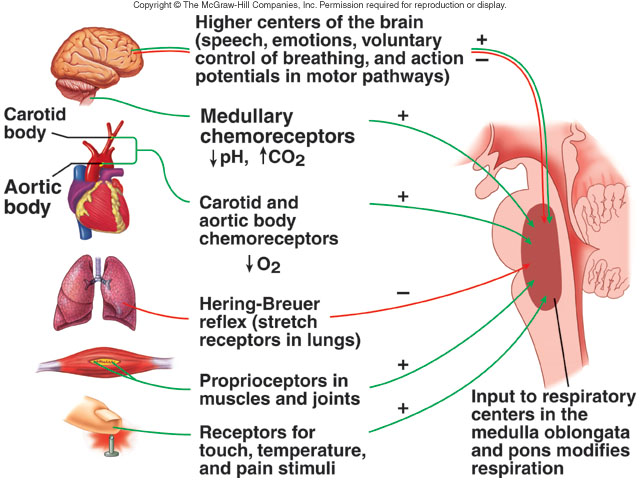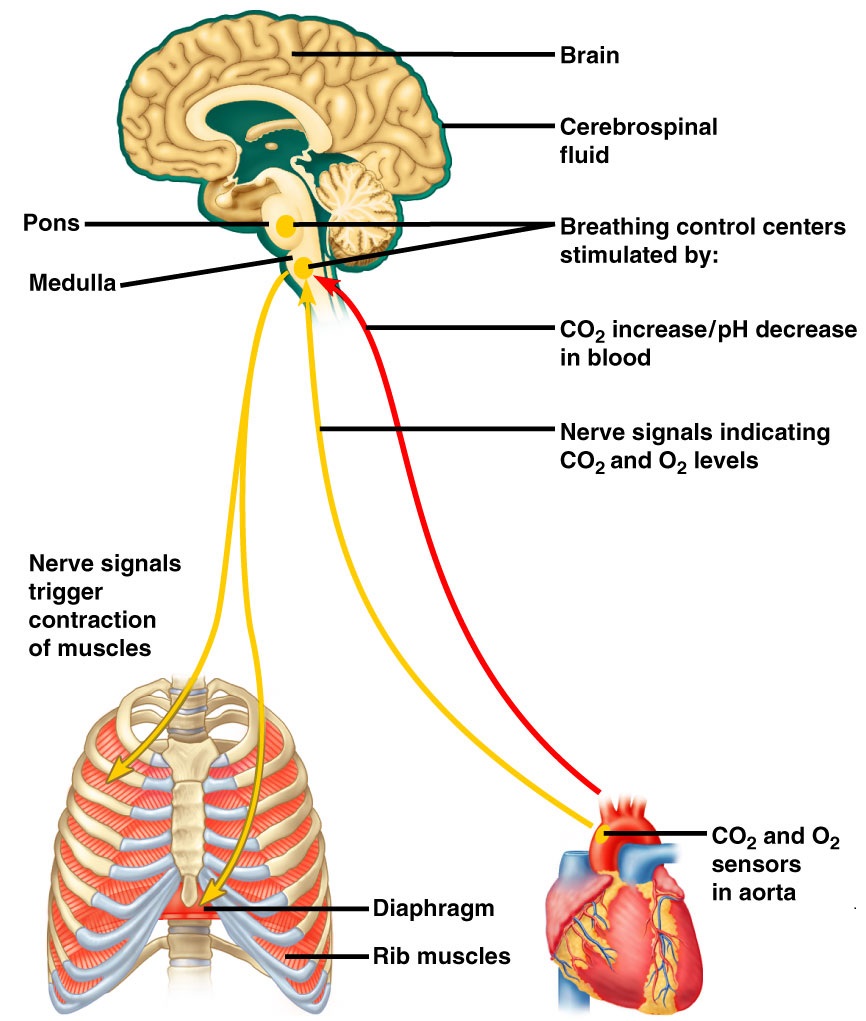Respiratory Center
Dr.A.P.Ganesan
Komarapalayam
Name the respiratory centers. Explain the natural regulation of respiration. Describe the Regulation or control of respiration.
Respiration
A reflex process, regulated by the respiratory centres
Respiratory Centers
Are the group of neurons which control the rate, rhythm and force of respiration
Located in the reticular formation in the brain stem.
Two groups.
1. Medullar centers
2. Pontine centers.
The medullar centers include
A inspiratory center
B Expiratory centers.
The pontine centers include
A. pneumotaxic centre
B. Apneustic centre
Inspiratory Center
Located in the upper part of the medulla oblongata
Formed by the inspiratory neurons
Concerned with inspiration.
The stimulation of this centre causes contraction of inspiratory muscles and inspiration.
Expiratory Center
Located in the medulla oblongata anterior and lateral to inspiratory center.
Formed by expiratory neurons
Normally the expiratory centre is inactive. It is activated when the inspiratory centre is inhibited.
Activation of expiratory center causes contration of expiratory muscles and expiration
Pneumotaxic Center
Situated in the dorsolateral part of the reticular formation in the pons.
Centrols the activity of medullary inspiratory centre.
It centrols the duration of respiration,
Increases the rate of respiration by reducing the duration of respiration
Apneustic Center
Situated in the reticular formation in lower part of Pons.
The stimulation of this center reduces the rate of respiration by increasing the duration of respiration
Efferent Pathway
The nerve fibres from the centres run downward to enter the spinalcord and end in the anterior horn cells
From these cells two sets of nerve fibres arise :-
1 Phrenie nerve to supply the diaphragm
2 Inter costal nerve to supply intercostal muscles
Afferent Pathway
Afferent impulses from the chemoreceptors and baroreceptors are carried to the respiratory center by the branches of 1. vagus nerve 2. Glossopharyngeal nerve
Mechanism of regulation of Respiration
Two mechanisms
1 Nervous mechanism
2 chemical mechanism, Both mechanism are reflex in nature
Nervous Mechanism
It is reflex in action. The reflex mediating the respiration is Herring Bruer reflex.
Hering Bruer reflex
Prevents over distension of the lungs during inspiration and collapse of the lungs during expiration.
The former is called hering bruer inflation reflex and the later is called hering bruer deflation reflex.
1.Hering Bruer inflation reflex.
The receptors for this reflex are stretch receptors - located in the lungs - mainly in the bronchi and bronchioles.
During inspiration, when the lung becomes stretched these recptors are stimulated.
Afferent impulses travel through the vagus nerve & reach respiratory center - exert an inspiration inhibiting effect - inspiration is cutoff in time and expiration commences.
2.Hering Bruer deflation reflex
The receptor for these reflex are compression receptors - located in the alveolar septa.
These are simulated during expiration and reflexly inhibit the expiration and reciprocally stimulate inspiration.
Afferent impulses are carried by the vagus nerve the efferent impulses are carried by phrenic and intercostals nerve to diaphragm and intercostals muscles
Chemical Mechanism
Also a reflex mechanism - mediated by chemorecptors.
These receptors are more sensitive to changes in the concentration of oxygen and carbon dioxide in the blood and CSF.
Located centrally and peripherally.
Central chemoreceptors
Located on the surface of medulla oblongata and are bathed in the CSF.
When the concentration of carbon dioxide in the arterial blood is increased, these recptors are stimulated
The afferent impulses stimulate the respiratory centers - the ventilation is increased and carbon dioxide is relieved from the blood,
When the oxygen concentration is reduced the same mechanism occurs
Peripheral chemorecebtors
Situated in the arch of aorta and carotid bodies,
Sensitive even to a small rise in the concentration of carbon dioxide in the arterial blood and low concentration of oxygen.
The afferent impulses conveyed by the glassopharyngeal nerve and vagus nerve to respiratory centre - respiratory centre is stimulated - rate and depth of the respiration are increased
Other factors influencing respiration
Breathing may be modified by higher centres in the brain by
1. Speech
2. Singing
3. Sleep
4. Sneezing
5. Swallowing
6. Temperature
7. Drugs-Sedatives, alcohol
8 emotions
9 Fever
10 cough
* * * * * * * * * * * * * * *



